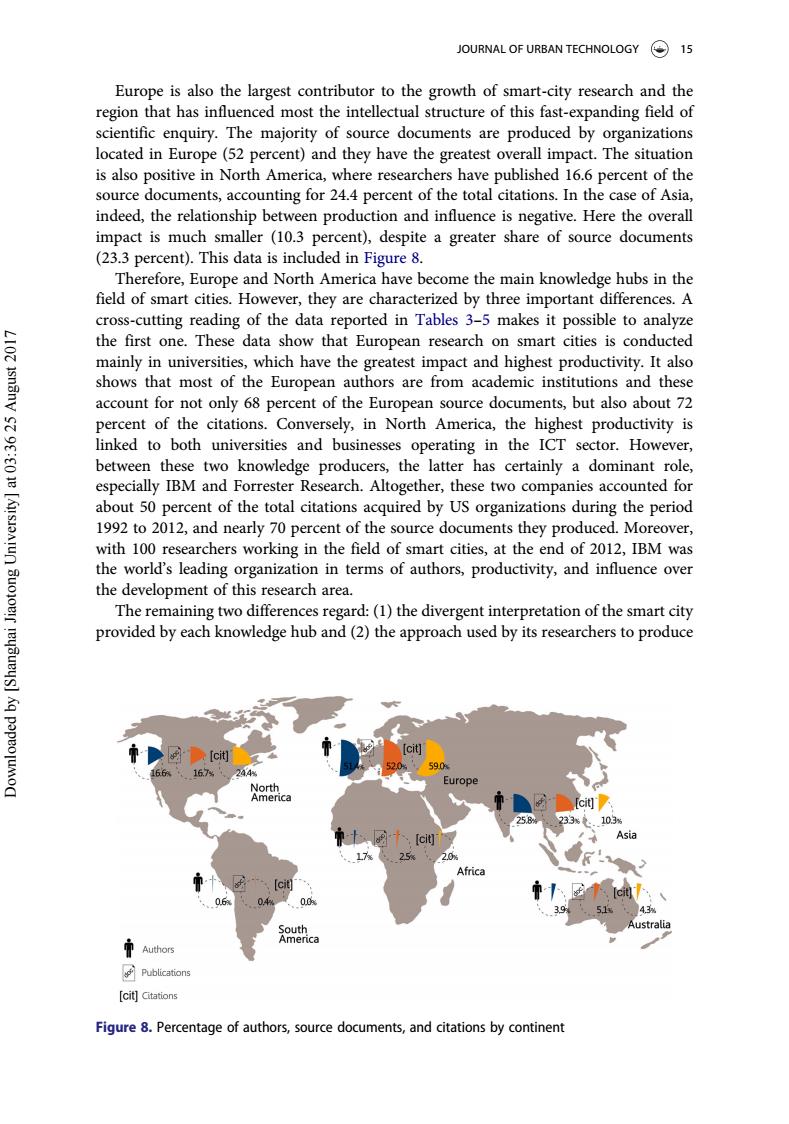正在加载图片...

JOURNAL OF URBAN TECHNOLOGY 15 Europe is also the largest contributor to the growth of smart-city research and the region that has influenced most the intellectual structure of this fast-expanding field of scientific enquiry.The majority of source documents are produced by organizations located in Europe (52 percent)and they have the greatest overall impact.The situation is also positive in North America,where researchers have published 16.6 percent of the source documents,accounting for 24.4 percent of the total citations.In the case of Asia, indeed,the relationship between production and influence is negative.Here the overall impact is much smaller (10.3 percent),despite a greater share of source documents (23.3 percent).This data is included in Figure 8. Therefore,Europe and North America have become the main knowledge hubs in the field of smart cities.However,they are characterized by three important differences.A cross-cutting reading of the data reported in Tables 3-5 makes it possible to analyze the first one.These data show that European research on smart cities is conducted mainly in universities,which have the greatest impact and highest productivity.It also LIOZ Isn3nV st 9:E0 [AISIaAlun shows that most of the European authors are from academic institutions and these account for not only 68 percent of the European source documents,but also about 72 percent of the citations.Conversely,in North America,the highest productivity is linked to both universities and businesses operating in the ICT sector.However, between these two knowledge producers,the latter has certainly a dominant role, especially IBM and Forrester Research.Altogether,these two companies accounted for about 50 percent of the total citations acquired by US organizations during the period 1992 to 2012,and nearly 70 percent of the source documents they produced.Moreover, with 100 researchers working in the field of smart cities,at the end of 2012,IBM was the world's leading organization in terms of authors,productivity,and influence over the development of this research area. 3uojoelf leyueyS]q papeojumod The remaining two differences regard:(1)the divergent interpretation of the smart city provided by each knowledge hub and(2)the approach used by its researchers to produce [cit] 244% North Europe America 103% Asia Africa 06 00 394 51 43% South Australia Publications [cit]Citations Figure 8.Percentage of authors,source documents,and citations by continentEurope is also the largest contributor to the growth of smart-city research and the region that has influenced most the intellectual structure of this fast-expanding field of scientific enquiry. The majority of source documents are produced by organizations located in Europe (52 percent) and they have the greatest overall impact. The situation is also positive in North America, where researchers have published 16.6 percent of the source documents, accounting for 24.4 percent of the total citations. In the case of Asia, indeed, the relationship between production and influence is negative. Here the overall impact is much smaller (10.3 percent), despite a greater share of source documents (23.3 percent). This data is included in Figure 8. Therefore, Europe and North America have become the main knowledge hubs in the field of smart cities. However, they are characterized by three important differences. A cross-cutting reading of the data reported in Tables 3–5 makes it possible to analyze the first one. These data show that European research on smart cities is conducted mainly in universities, which have the greatest impact and highest productivity. It also shows that most of the European authors are from academic institutions and these account for not only 68 percent of the European source documents, but also about 72 percent of the citations. Conversely, in North America, the highest productivity is linked to both universities and businesses operating in the ICT sector. However, between these two knowledge producers, the latter has certainly a dominant role, especially IBM and Forrester Research. Altogether, these two companies accounted for about 50 percent of the total citations acquired by US organizations during the period 1992 to 2012, and nearly 70 percent of the source documents they produced. Moreover, with 100 researchers working in the field of smart cities, at the end of 2012, IBM was the world’s leading organization in terms of authors, productivity, and influence over the development of this research area. The remaining two differences regard: (1) the divergent interpretation of the smart city provided by each knowledge hub and (2) the approach used by its researchers to produce Figure 8. Percentage of authors, source documents, and citations by continent JOURNAL OF URBAN TECHNOLOGY 15 Downloaded by [Shanghai Jiaotong University] at 03:36 25 August 2017